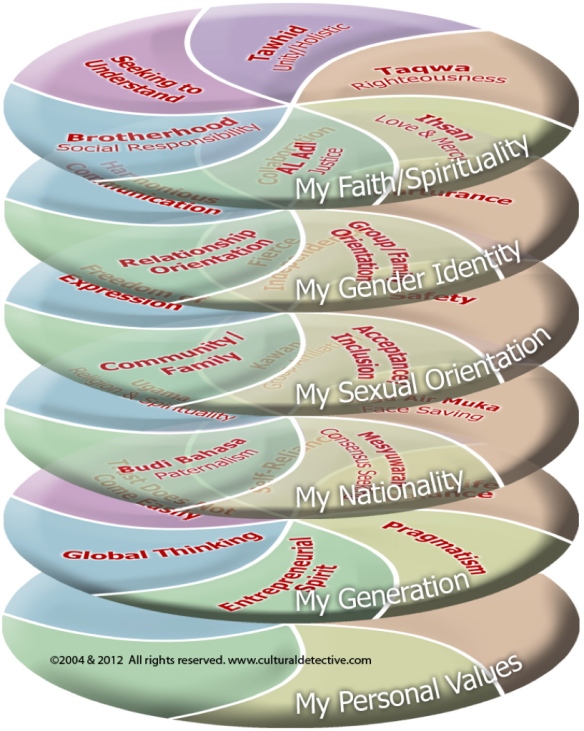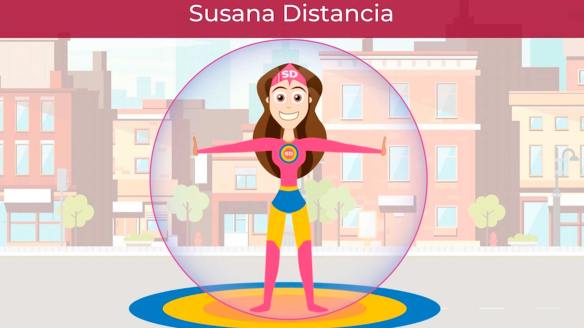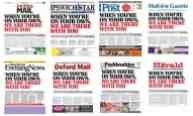
Please help me credit the creator of this image.
The COVID-19 pandemic is uniting our planet as well as dividing it in powerful ways. Many of us now share the common experiences of travel bans, hand washing, masks, quarantine, job loss or working from home, and economic uncertainty. Many of us are worried, trying our best to stay positive, doing constructive projects around the house, including exercise to stay in shape and online classes. Neighbors are reaching out to neighbors in life-affirming ways, making sure disadvantaged children and elderly shut-ins get sustenance and feel cared for, singing and playing with one another across balconies. We’ve had the privilege of enjoying gorgeous online concerts from some of the world’s best performing artists, playing in unison from the privacy of their homes directly into ours through the wonders of technology. “Light it Blue” united much of our world to thank healthcare workers and essential service providers.
Those who were already marginalized before the coronavirus due to our inequitable systems are suffering horribly now: the homeless, those barely subsisting in “normal” times, those without access to healthcare, those without internet to keep them connected or rooms in which to isolate people infected. Racial disparities show horrifying differences in survival rates, and many nations’ deplorable treatment of migrants and indigenous communities has had negative repercussions during the pandemic. Many disbelieve, convinced COVID-19 is a hoax, accusing politicians and the media of over-hyping the situation. We’ve all received loads of life-threateningly dangerous fake news, rumors and home remedies in our cell phones. Click on any photo to enlarge it or view a slideshow.
We’ve witness amazing international collaboration on scientific research, testing and vaccine preparation. And, we’ve also seen horrible competition for medical equipment. Open Government Partnership members are sharing best practices worldwide in an effort to help others. It seems the crisis has brought out both the best and the worse, magnifying what works and what’s broken in our society. Will the pandemic finally wake us up so that we work to build a more equitable future? Or, heartbreakingly, will our enterprise and our governments use it as a distraction to take further advantage of the marginalized?
Countries worldwide have had broadly differing responses to COVID-19 ranging from eradication (Taiwan) to containment (Australia) and extremely centralized authority (China) to trusting individuals to make the best decisions (Sweden). I recently read that the six countries with the most effective responses to the pandemic thus far (Belgium, Finland, Denmark, Germany, Iceland, and New Zealand) are all led by women! And that article doesn’t include the East Asian poster child—Taiwan, also led by a woman. Most credit these nations’ proactive decision making, persistence, meaning making, swift action, empathy building, coordinated efforts, and the fact that they were better prepared in terms of medical care and protective equipment (check out the Cultural Detective Women’s Values Lens and you might get some clues as to why).
 EXERCISE
EXERCISE
I’ve collected artifacts (posters, videos, slogans, images) from our worldwide response to the pandemic, and urge you to log into Cultural Detective Online, bring up the Values Lenses for the cultures in question, and use those values to help decipher the cultural influences at play in the messaging you see in this article. Osnat Lautman wrote an article on Israeli values and response to coronavirus that may give you an idea how to connect values to behavior.
To begin, I think it could be helpful to work with a collection of Chinese posters on COVID-19 with English translations. Focusing on one national culture as a first step will be an easy way to get started. Read the posters below and think about the underlying values at play in these attempts to motivate citizens. Then, use the Cultural Detective China Values Lens to help you go deeper.
Every nation, of course, has huge cultural diversity: regional, ethnic, socio-economic, gender, generational… Once you’ve analyzed the messaging from a national cultural viewpoint, pull up a complementary Cultural Detective Values Lens for gender, generation, sexual orientation, or spiritual tradition and see how someone with those values might respond to the messaging. And, remember, each of us are unique individuals, with multiple layers of cultural influences on our behavior.
SOCIAL DISTANCING
While social distancing has been nearly a universal response to COVID-19, the distance seems to vary between one and two meters depending on location. How that distance is communicated, however, can vary widely by culture. The goal of such posters, of course, is to grab attention and stick in the memory. The culture of National Park users in the USA and the culture of bicyclists and runners have also been affected by news of how the virus can spread in one’s slipstream, as you’ll see in a couple of the posters below.
POSTERS
That trend continues across other official COVID-19 messaging. While most governments encourage citizens to wash their hands frequently, use antibacterial gel, cover their sneezes and coughs, stay home, and not touch their faces, how those messages are communicated does vary by culture. Most attempt to find a balance between calm, instructive encouragement and a sense of urgency about the seriousness of the situation. Some posters use cartoons, others simple symbols, others data and facts. What cultural similarities and differences do you note in the posters below?
MUSIC VIDEOS
Quite a few nations have put out catchy tunes to inform the public how to stay safe during the pandemic. One of the most popular, with nearly 40 million views, is Vietnam’s Ghen Cô Vy—which equates the coronavirus to a troublemaker who jealously tries to break up a couple. The song even inspired a dance challenge on social media app TikTok. The cute animation includes a bit of national pride, with an animated Vietnamese flag waving with the words: “Vietnam is determined to beat this disease.”
One of my favorites is a music video performed by the employees of Bangkok’s BTS Skytrain:
Below is Philippines’ very popular song about coronavirus. I sadly couldn’t find a version with English subtitles; if you do, please let me know and I’ll substitute it in.
My absolute favorite, however, is Bobi Wine and Nubian’s effort to help fellow Ugandans. In a true spirit of collaboration, they’ve openly licensed the track, encouraging musicians worldwide to “sing our song in your language and for your people!”
Speaking of music videos, we can’t forget Bollywood. Muskurayega India (India Will Smile) has 10 million views on YouTube.
Iranian comedian Danial Kherikhan wins my award for world’s best hand washing technique:
What culture-specific values and behaviors do you see in the videos above? Which are you attracted to and why? Most probably, it resonates with one or more of the values you hold dear. Which video disinterests you the most? Again, that probably tells you something about your personal and cultural values. Open your subscription to Cultural Detective Online, go to the Self Discovery package, and create a Personal Values Lens.
MASCOTS
In Mexico where I live, people greet with big bear hugs and kissing. It’s incredibly rude not to properly greet or take leave, so the national government came up with an inspired campaign to give people permission not to greet.

Once the cartoon superhero called “Susana Distancia” (translates to “your safe distance”) came on the scene, it very quickly became common for Mexican friends to hold up their arms or pucker their lips from a distance and refer to Susana. Intercultural competence is crucial in our world today, and particularly so during a crisis, when the difference between engagement and disengagement can mean life and death.
MASKS
One of the most visible cultural differences in response to COVID-19 has been in the wearing of masks. East Asians have a tradition of wearing masks during illnesses and to protect against pollution, while most of the West has been much slower to adopt this practice. The Czech Republic mandated the wearing of masks in public on March 18th; their results no doubt have helped other western nations to adopt the practice. Face masks first made it to fashion runways in China in 2014, and masks were well represented this year at Paris Fashion Week. It is interesting to watch cultural resistance fade and behavior change in such a large and important way.
Many of us have not only learned to wear masks, but we’ve also picked up new vocabulary during this crisis, via the popularization of words such as “PPE/Personal protective equipment” and the recycling of valuable-yet-neglected terms like “common good.” Many of us have also re-learned elementary and middle school biology lessons about the difference between a bacterium and a virus and how to kill them.
TECHNOLOGY: HELP LINES, APPS, QUIZZES AND COORDINATED MEDIA
Many communities leveraged technology to help citizens. We have seen apps for COVID-19 tracking, quizzes to help diagnose, telephone helplines, and united messaging across newspapers, radio and television and, in Latin America at least, across countries. While the use of technology favors the higher socio-demographics and the young, public visual and performance art are much more inclusive (at least before we isolated at home, if we have one).
STREET ART
Street artists around the world have pitched in to help get the word out. Street performances, visual art, and the songs mentioned above are particularly helpful with largely illiterate populations, but I believe if we researched it a bit, we’d find the multi-sensory learning advantages of these methods work well everywhere. I especially loved this collection of beautiful images from Senegal:
In Indonesia a youth drama troupe took to the streets to scare citizens into staying home.
COMMUNITY-SPECIFIC MESSAGING
The differing histories and heritages of our world populations mean that cultural communities have to tailor their responses to the pandemic. Native Americans, for example, suffered germ warfare not so very long ago. This latest virus resurrects that inter-generational trauma, and has led to responses ranging from connecting with tradition to innovative world-class field hospitals.
CREATIVITY AND CITIZEN INVOLVEMENT
A crisis brings out creativity and innovation as we’ve seen in India where, after suspending operations of the world’s fourth largest train system and the country’s biggest employer, they are converting train cars into temporary hospitals. Graphic artists have pitched in, creating pieces to help spread awareness and save lives. Weiman Kow created “comics for good” and opened them up to the public for translations. Germany held a hackathon to generate ideas for improving pandemic response. And Ireland’s public health service has made posters available in multiple languages.
I have said since the beginning that COVID-19 is Mother Nature’s way of putting us in timeout so she can clean her air and give her animals and plants a respite. Sure enough, we are all enjoying gorgeous video of clean water in rivers (the Ganges runs clear and some say it’s again drinkable!), lakes and ocean beaches, clear skies over normally grey, polluted cities, and wild animals (elk, fox, boar, deer, even wolves) strolling through the streets of towns and cities where they haven’t been seen sometimes in hundreds of years! One sad reality, though, is an abundance of single-use masks and latex gloves in our waterways.
There are so many cultural universals and cultural differences on display right now, as our world faces a shared enemy in a small but lethal virus. Will we learn from the time many of us have had to reflect, and change our behavior going forward? Will we act as better stewards of our environment? Will we act to create more equitable systems in which all are fed, housed, educated and receive medical care? I sure hope so! We are in this together, we share one planet, everyone’s participation and expertise is crucial, and collaboration is our future.








































Hi Dianne, Thank you for your brilliantly curated collection!! Of course, you always take the global perspective. I have one thing to add: I just wrote an article on the founders of Cafe Ohlone, California’s first Indigenous restaurant and how the wisdom of their ancestors can help us all
https://www.berkeleyside.com/2020/04/15/cafe-ohlone-berkeley-pandemic-preparedness
LikeLike
Awesome! I’ll share it. Would you please share this around? Thanks! 😘
LikeLike
Dianne, What a brilliant collection and culture learning package! I will definitely pass this on. Thank you. XXX
LikeLike
Thanks for letting me know, gorgeous. I hope you are well and safe. The new dog sounds wonderful!
LikeLike
Hi Dianne, what a wonderful compilation! I will certainly share. I have been working in African and Asian countries over the last 18 years and love what you have put together. In the past 6 months I did receive a lot of requests from organisations in Africa to illustrate signage for the Coronavirus, without language and multicultural. A challenge that I have taken up enthusiastically!
The initiative kept on growing as more request where coming in, resulting in more than 400 unique multicultural printable COVID-19 signs and posters, which I would like to share:
https://covid19signs.com/
There are a lot of signs and posters on the internet, but multicultural COVID 19 posters are not always easy to find for the people who may benefit from it. The only other way to let as many people as possible benefit from this initiative is to let them know that this initiative exists.
Would you from that perspective be willing to share this message with the people in your network? That would be very much appreciated!
Greetings,
Arjen
LikeLike
Wonderful, Arjen! Thank you for sharing these with our community!!!
LikeLike